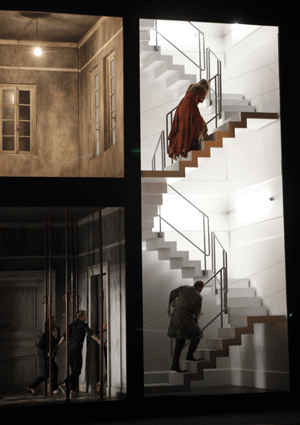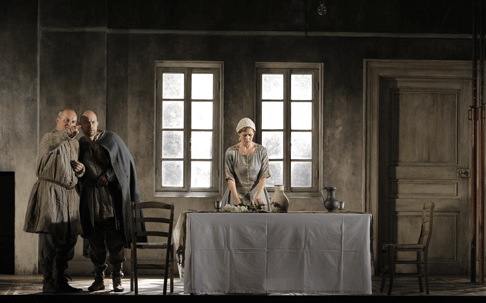Because Written on Skin seems to be about every thing you can think of, let us just say it is about being alive and knowing it. The artistic trick in Written on Skin is this huge revelation, which is art itself. It is big art, hard art, tender art, brutal art. Written on Skin above all is very real art.

Written on Skin is a libretto and its music — not since Monteverdi have music and words combined with more force and clarity. Playwright Martin Crimp distills a thousand years of images and issues into a brief text that composer George Benjamin embodies in one hour and forty minutes of sounds that defy definition.
If opera is essentially sex and violence Written on Skin well qualifies, Benjamin’s score magnifies the strange and delicate sexual stirrings that Benjamin Britten musically discovered and carries these urges to powerful and violent climax, rendering Britten’s guilty regret into utter hopelessness. And there is the sonic scope of timeless Messiaen transferred from God’s lofty nature to the creator’s own, base human nature. It is the sonic gamut of human nature.
It was an exhilarating evening that owes everything to everyone who created it, an astounding portrayal of the wife Agnes by soprano Barbara Hannigan, at once the fourteen year-old girl, the bride, the subject of her husband and an animal in heat. Baritone Christopher Purves made a profoundly moving portrayal of the Protector, Agnes’ husband, provider and, yes, protector and victim. The Boy, the medieval and timeless illuminator who was at once artist, innocence, lover and angel, was countertenor Bejun Mehta in beautiful voice and charismatic character.
Two additional presences complete Martin Crimp’s humanity, the female, mezzo soprano Rebecca Jo Loeb, consumed by unconsecrated sexuality, her essence played out on the senses of her skin. She is a lost, unredeemed angel. Her husband, baritone Allan Clayton, like the Protector is an actor in the world, like all men unprotected, ineffectual and meaningless. He too is an unredeemed angel.

Metteur en scËne Katie Mitchell and scenographer Vicki Mortimer echoed the complexities of the Crimp text within five designated spaces on the split level stage to move between dialogue and narration, from action to description, from self discovery to self-conscious notation. High above was the artist’s studio where the world’s happenings are recorded, and next to it a verdant space with a window looking into something, maybe fulfillment, below a sort of ante-room to heaven and hell next to the world stage that was a room in the Protector’s house, both heaven and hell.
A side space in nature gave way in the last of the three part opera (marked by two brief pauses) to a coup de thÈ‚tre — the sudden apparition of a stairway ascending to undefined spaces above the stage where Agnes climbed to a sort of redemption. At last, served for dinner the heart of the boy, the artist, the lover, she knows that nothing will ever take its taste from her mouth, erase the boy’s pictures from her skin.
Like Bartok’s Bluebeard’s Castle, Written on Skin is a horror story, a journey into the darkest abyss’s to be tread by the human spirit. It brings the fascination and exhilaration of a glimpse into a psychic place one should never enter without the protection of really good art. Like Written on Skin.
Michael Milenski
image=http://www.operatoday.com/WRITTEN634a.gif
image_description=Photo © Pascal Victor / Artcomart, courtesy of Festival d’Art Lyrique d’Aix en Provence
product=yes
product_title=George Benjamin: Written on Skin
product_by=The Protector: Christopher Purves; AgnËs: Barbara Hannigan; Angel 1/The Boy: Bejun Mehta; Angel 2/Marie: Rebecca Jo Loeb; Angel 3/John; Allan Clayton. Mahler Chamber Orchestra. Conductor: George Benjamin; Mise en scËne: Katie Mitchell; Scenography and Costumes: Vicki Mortimer; Lighting: Jon Clark. Grand ThÈ‚tre de Provence, Aix-en-Provence. 7 July 2012.
product_id=Photos © Pascal Victor / Artcomart, courtesy of Festival d’Art Lyrique d’Aix en Provence.